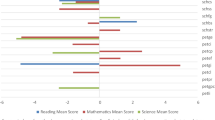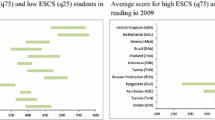Abstract
Digital technology has become an indispensable component in education around the world. Despite its growing importance, a gap in students’ digital skills and usage based on their socioeconomic status—known as the second digital divide—has been identified in a wide range of countries. Using data from the 2009 OECD Programme for International Student Assessment, we consider two aspects of the second digital divide for 15-year-olds across 55 countries: the gaps in use of educational software at home and Internet literacy. Specifically, we ask whether national income, political freedom, and national investments in research and development (R&D) and secondary education are associated with the second digital divide. We find that national income predicts the digital divide and that national investments have differential effects depending upon a country’s income. R&D spending reduces the socioeconomic gap in educational software use only in low-income countries. Educational expenditures reduce the Internet literacy gap in high-income countries while exacerbating it in low-income ones. Additional analyses suggest that income inequality increases the digital divide, but like political freedom, the effects become non-significant when national income is considered. We conclude by discussing the implications of these findings for policymakers interested in reducing the digital divide.


Similar content being viewed by others
Notes
Research from Australia (OECD 2011) and Cyprus (Milioni et al. 2014) suggests a “reverse digital divide” between immigrants and nonimmigrants; that is, there is a “compensatory or remedial use of the Internet (Milioni et al. 2014, p. 333)” by racial minority immigrants in order to overcome their existing racial and social barriers.
The gross national income per capita for low-income countries is below $4570 in U.S. dollars; medium-income countries are between $4571 and $14,090; and upper- and high-income countries are above $14,091.
To account for the possibility that countries with large sample sizes may disproportionately affect parameter estimates, we run supplementary analyses with a variable measuring country sample size and find our results to be unchanged.
Seven online activities are listed in the questionnaire. We excluded two of these activities—reading emails and chatting online—as they are less relevant to students’ online literacy and reading proficiency (OECD 2011).
Some studies use the number of books at home as a proxy for family SES or social class (Carnoy and Rothstein 2013). We consider this alternative in supplementary analyses and find the results to be substantively the same.
For countries that have missing data on country-level variables in 2009, we utilize data from the closest adjacent year in which data are available (see Table 6 in the Appendix).
Because the composite polity score ranges from − 10, to 10, we take a linear transition by adding 11 before logging to ensure that all values are positive.
To avoid over-parameterization, we do not consider the random slopes of other individual-level variables. In models not shown, we find the inclusion of additional random slopes does not influence the main results reported here. Additionally, we find family SES to be much more important than other variables in capturing cross-cluster heterogeneity. These models are available upon request.
In supplementary analyses including both R&D and educational expenditures, the significant effect of R&D disappears because of the high correlation between the two variables (r = .48), but the general patterns remain the same.
Trinidad & Tobago and Macao are potential outliers in Fig. 2 with regard to the effect of R&D for high-income nations. Supplementary analyses excluding these two countries show patterns consistent with those reported here.
Results from supplementary analyses are not shown here, but are available from the authors upon request.
Based on the World Bank, there are 6 lower-middle-income countries, 15 upper-middle-income countries, and 34 high-income countries.
While educational expenditures have a clear and direct relationship to students, countries may distribute their educational resources in ways that are unrelated to digital technology use. The distribution of educational investments within a country could also be biased by social status, with newer technologies going only to schools in the most affluent areas. Bearing these possibilities in mind, we examine whether or not these investments, when used appropriately, may serve as tools to reduce the second digital divide.
References
Attewell, P. (2001). The first and second digital divides. Sociology of Education, 74(3), 252–259.
Attewell, P. (2003). Beyond the digital divide. In P. Attewell & N. Seel (Eds.), Disadvantaged Teens and Computer Technologies (pp. 15–34). New York: Waxmann.
Attewell, P., Suazo-Garcia, B., & Battle, J. (2003). Computers and young children: Social benefit or social problem? Social Forces, 82(1), 277–296.
Baker, D., Goesling, B., & LeTendre, G. (2002). Socioeconomic status, school quality, and national economic development: A cross-national analysis of the “Heyneman-Loxley Effect” on mathematics and science achievement. Comparative Education Review, 46(3), 291–312.
Becker, H. J. (2000). Who’s wired and who’s not: Children’s access to and use of computer technology. The Future of Children, 10(2), 44–75.
Bonfadelli, H. (2002). The internet and knowledge gaps: A theoretical and empirical investigation. European Journal of Communication, 17(1), 65–84.
Brown, P. (2013). Education, opportunity and the prospects for social mobility. British Journal of Sociology of Education, 34(5–6), 678–700.
Bryan, M., & Jenkins, S. (2016). Multilevel modelling of country effects: A cautionary tale. European Sociological Review, 32(1), 3–22.
Buchmann, C., & Hannum, E. (2001). Education and stratification in developing countries: A review of theories and research. Annual Review of Sociology, 27, 77–102.
Carnoy, M., & Rothstein, R. (2013). What do international tests really show about U.S. student performance? http://www.epi.org/publication/us-student-performance-testing/. Accessed Oct 2015.
Chankseliani, M. (2014). Georgia: Marketization and education post-1991. In N. Ivanenko (Ed.), Education in eastern Europe and Eurasia (pp. 277–302). London; New York: Bloomsbury Academic.
Chiu, M. M. (2010). Effects of inequality, family and school on mathematics achievement: Country and student differences. Social Forces, 88(4), 1645–1676.
Corrales, J., & Westhoff, F. (2006). Information technology adoption and political regimes. International Studies Quarterly, 50(4), 911–933.
Dale, R. (2005). Globalisation, knowledge economy and comparative education. Comparative Education, 41(2), 117–149.
DeBell, M., & Chapman, C. (2006). Computer and internet use by students in 2003 (NCES 2006-065). Washington, DC: U.S. Department of Education. National Center for Education Statistics.
Decancq, K., & Schokkaert, E. (2016). Beyond GDP: Using equivalent incomes to measure well-being in Europe. Social Indicators Research, 126(1), 21–55. https://doi.org/10.1007/s11205-015-0885-x.
DiMaggio, P., & Cohen, J. (2005). Information inequality and network externalities: A comparative study of the diffusion of television and the Internet. In V. Nee & R. Swedberg (Eds.), The economic sociology of capitalism. Princeton: Princeton University Press.
DiMaggio, P., Hargittai, E., Celeste, C., & Shafer, S. (2004). Digital inequality: From unequal access to differentiated use. In K. Neckerman (Ed.), Social inequality (pp. 355–400). New York: Russell Sage Foundation.
Drori, G. S. (2006). Global e-litism: Digital technology, social inequality, and transnationality. New York, NY: Worth Publishers.
Drori, G. S. (2010). Globalization and technology divides: Bifurcation of policy between the “digital divide” and the “innovation divide”. Sociological Inquiry, 80(1), 63–91.
Dutton, W. H., Gillett, S. E., McKnight, L. W., & Peltu, M. (2004). Bridging broadband Internet divides: Reconfiguring access to enhance communicative power. Journal of Information Technology, 19(1), 28–38.
Education Services Australia. (2012). National digital learning resources network. http://www.ndlrn.edu.au/default.asp. Accessed July 2015.
Elwert, F., & Winship, C. (2014). Endogenous selection bias: The problem of conditioning on a collider variable. Annual Review of Sociology, 40, 31–53.
Erichsen, E. A., & Salajan, F. D. (2014). A comparative analysis of e-learning policy formulation in the European Union and the United States: Discursive convergence and divergence. Comparative Education Review, 58(1), 135–165.
Fuchs, T., & Wossmann, L. (2004). Computers and student learning: Bivariate and multivariate evidence on the availability and use of computers at home and at school. Brussels Economic Review, 47(3–4), 359–386.
Gamoran, A. (2001). American schooling and educational inequality: A forecast for the 21st century. Sociology of Education, 74, 135–153.
Ganzeboom, H. B. G., De Graaf, P. M., & Treiman, D. J. (1992). A standard international socio-economic index of occupational status. Social Science Research, 21(1), 1–56.
Goode, J. (2010). The digital identity divide: How technology knowledge impacts college students. New Media and Society, 12(3), 497–513.
Guillén, M. F., & Suárez, S. L. (2005). Explaining the global digital divide: Economic, political and sociological drivers of cross-national Internet use. Social Forces, 84(2), 681–708.
Hannum, E., & Buchmann, C. (2005). Global educational expansion and socio-economic development: An assessment of findings from the social sciences. World Development, 33(3), 333–354.
Hargittai, E., & Hinnant, A. (2008). Digital inequality: Differences in young adults’ use of the Internet. Communication Research, 35(5), 602–621.
Hargittai, E., & Shafer, S. (2006). Differences in actual and perceived online skills: The role of gender. Social Science Quarterly, 87(2), 432–448.
Heisig, J. (2011). Who does more housework: Rich or poor? A comparison of 33 countries. American Sociological Review, 76(1), 74–99.
Heisig, J., Schaeffer, M., & Giesecke, J. (2017). The costs of simplicity: Why multilevel models may benefit from accounting for cross-cluster differences in the effects of controls. American Sociological Review, 82(4), 796–827.
Heyneman, S. P., & Loxley, W. A. (1983). The effect of primary-school quality on academic achievement across twenty-nine high- and low-income countries. American Journal of Sociology, 88(6), 1162–1194.
Hilbert, M. (2010). When is cheap, cheap enough to bridge the digital divide? Modeling income related structural challenges of technology diffusion in Latin America. World Development, 38(5), 756–770.
Hill, P. (2010). Learning as we go: Why school choice is worth the wait. Stanford, CA: Hoover Institution Press.
Imhof, M., Vollmeyer, R., & Beierlein, C. (2007). Computer use and the gender gap: The issue of access, use, motivation, and performance. Computers in Human Behavior, 23(6), 2823–2837.
ITU. (2011). Measuring the information society. Geneva: ITU. http://www.itu.int/en/ITU-D/Statistics/Pages/publications/mis2011.aspx. Accessed Dec 2013.
Juárez, F., & Gayet, C. (2014). Transitions to adulthood in developing countries. Annual Review of Sociology, 40, 521–538.
Kim, S.-H. (2008). Testing the knowledge gap hypothesis in South Korea: Traditional news media, the Internet, and political learning. International Journal of Public Opinion Research, 20(2), 193–210.
Leu, D. J., Forzani, E., Rhoads, C., Maykel, C., Kennedy, C., & Timbrell, N. (2014). The new literacies of online research and comprehension: Rethinking the reading achievement gap. Reading Research Quarterly, 50(1), 37–59.
Leung, L., & Lee, P. S. N. (2012). Impact of Internet literacy, Internet addiction symptoms, and Internet activities on academic performance. Social Science Computer Review, 30(4), 403–418.
Livingstone, S., & Helsper, E. J. (2008). Parental mediation and children’s internet use. Journal of Broadcasting and Electronic Media, 52(4), 581–599.
Marshall, M. G., Gurr, T. R., & Jaggers, K. (2010). Polity IV project: Political regime characteristics and transitions, 1800–2009. http://www.systemicpeace.org/polity/polity4.htm. Accessed Nov 2011.
Mayer, S. E. (2001). How did the increase in economic inequality between 1970 and 1990 affect children’s educational attainment? American Journal of Sociology, 107(1), 1–32.
Milioni, D., Doudaki, V., & Demertzis, N. (2014). Youth, ethnicity, and a ‘reverse digital divide’: A study of Internet use in a divided country. Convergence: The International Journal of Research into New Media Technologies, 20(3), 316–336.
Natriello, G. (2001). Bridging the second digital divide: What can sociologists of education contribute? Sociology of Education, 74(3), 260–265.
Norris, P. (2001). Digital divide? Civic engagement, information poverty, and the Internet worldwide. New York: Cambridge University Press.
Notten, N., Peter, J., Kraaykamp, G., & Valkenburg, P. M. (2009). Research note: Digital divide across borders—A aross-national study of adolescents’ use of digital technologies. European Sociological Review, 25(5), 551–560.
OECD. (2011). PISA 2009 results: Students on line: Digital technologies and performance (volume VI). Paris: OECD Publishing. https://doi.org/10.1787/9789264112995-en.
OECD. (2012). PISA 2009 technical report. PISA, OECD Publishing. http://dx.doi.org/10.1787/9789264167872-en.
OECD. (2015). Students, computers and learning: Making the connection. Paris: PISA, OECD Publishing. https://doi.org/10.1787/9789264239555-en.
Park, H., & Kyei, P. (2011). Literacy gaps by educational attainment: A cross-national analysis. Social Forces, 89(3), 879–904.
Peter, J., & Valkenburg, P. M. (2006). Adolescents’ internet use: Testing the “disappearing digital divide” versus the “emerging digital differentiation” approach. Poetics, 34(4–5), 293–305.
Powell, W. W., & Snellman, K. (2004). The knowledge economy. Annual Review of Sociology, 30, 199–220.
Rabe-Hesketh, S., & Skrondal, A. (2008). Multilevel and longitudinal modeling using Stata. College Station, TX: Stata Press.
Raftery, A. E., & Hout, M. (1993). Maximally maintained inequality: Expansion, reform, and opportunity in Irish education, 1921–75. Sociology of Education, 66(1), 41–62.
Robinson, L. (2014). Freeways, detours, and dead ends: Search journeys among disadvantaged youth. New Media and Society, 16(2), 234–251.
Robison, K. K., & Crenshaw, E. M. (2010). Reevaluating the global digital divide: Socio-demographic and conflict barriers to the Internet revolution. Sociological Inquiry, 80(1), 34–62.
Royston, P., Carlin, J., & White, I. (2009). Multiple imputation of missing values: New features for mim. Stata Journal, 9(2), 252–264.
Ruiter, S., & van Tubergen, F. (2009). Religious attendance in cross-national perspective: A multilevel analysis of 60 countries. American Journal of Sociology, 115(3), 863–895.
Smith, J., Skrbis, Z., & Western, M. (2013). Beneath the ‘digital native’ myth: Understanding young Australians’ online time use. Journal of Sociology, 49(1), 97–118.
Snow, C. (2002). Reading for understanding: Toward an R&D program in reading comprehension. Santa Monica, CA: RAND Corporation.
Spring, J. (2008). Research on globalization and education. Review of Educational Research, 78(2), 330–363.
UNESCO. (2015). Education for all 2000–2015: Achievements and challenges. Paris: UNESCO. https://en.unesco.org/gem-report/report/2015/education-all-2000-2015-achievements-and-challenges#sthash.bfFmEFAV.dpbs. Accessed July 2015.
UNESCO. (2016). Information and communication technologies for development (ICT4D). http://www.ict4dc.org/. Accessed July 2015.
UNU-WIDER. (2008). World income inequality database, version 2.0c, May 2008. http://www.wider.unu.edu/research/Database/en_GB/wiid/. Accessed Jan 2013.
U.S. Department of Education. (1996). Getting America’s students ready for the 21st century: Meeting the technology literacy challenge. A report to the nation on technology and education. http://eric.ed.gov/?id=ED398899. Accessed June 2015.
van Deursen, A., & van Dijk, J. (2014). The digital divide shifts to differences in usage. New Media and Society, 16(3), 507–526.
Vegas, E., & Coffin, C. (2015). When education expenditure matters: An empirical analysis of recent international data. Comparative Education Review, 59(2), 289–304.
Worden, E. A. (2014). Moldova: Challenges and opportunities. In N. Ivanenko (Ed.), Education in Eastern Europe and Eurasia (pp. 47–64). London: Bloomsbury Academic.
World Bank. (2015a). World development indicators. http://databank.worldbank.org/data/download/archive/WDI_excel_2015_01.zip. Accessed Apr 2016.
World Bank. (2015b). Education statistics. http://data.worldbank.org/data-catalog/ed-stats. Accessed Oct 2015.
World Bank. (2015c). Why use GNI per capita to classify economies into income groupings? https://datahelpdesk.worldbank.org/knowledgebase/articles/378831-why-use-gni-per-capita-to-classify-economies-into. Accessed Feb 2015.
Acknowledgements
The authors would like to thank Brian Powell, Michael Wallace, Jeremy Pais, Mary Fischer, David Weakliem, Thung-Hong Lin, and several anonymous reviewers for valuable comments on previous versions of this paper.
Author information
Authors and Affiliations
Corresponding author
Appendix
Appendix
See Tables 5 and 6 and Fig. 3.
Effects of R&D and secondary educational expenditures on family SES slopes by country income group: digital use for schoolwork at home vs. use of educational software at homea. Note Predicted family SES slopes are based on the same model specifications in Table 4 but limited to only 36 countries with valid data for the two dependent variables. a Standardized composite measure based on five items: (1) browsing the Internet for schoolwork, (2) using e-mail to communicate with other students about schoolwork, (3) using e-mail to communicate with teachers and for submission of schoolwork, (4) using material from the school’s website, and (5) checking the school’s website for announcements
Rights and permissions
About this article
Cite this article
Ma, J.KH., Vachon, T.E. & Cheng, S. National Income, Political Freedom, and Investments in R&D and Education: A Comparative Analysis of the Second Digital Divide Among 15-Year-Old Students. Soc Indic Res 144, 133–166 (2019). https://doi.org/10.1007/s11205-018-2030-0
Accepted:
Published:
Issue Date:
DOI: https://doi.org/10.1007/s11205-018-2030-0





